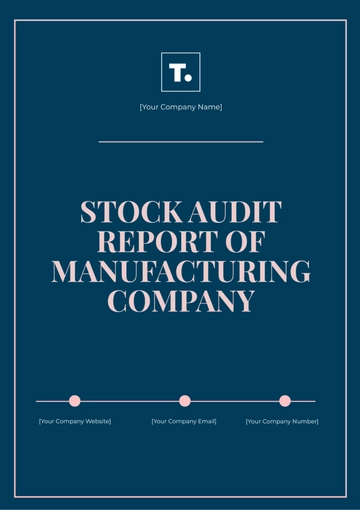Free Stock Audit Report of Manufacturing Company

Prepared By: [YOUR NAME]
Date: [DATE]
Company Name | [YOUR COMPANY NAME] |
Name | [YOUR NAME] |
[YOUR EMAIL] | |
Phone Number | [YOUR COMPANY NUMBER] |
Address | [YOUR COMPANY ADDRESS] |
Website | [YOUR COMPANY WEBSITE] |
1. Executive Summary
This Stock Audit Report provides an in-depth examination of [YOUR COMPANY NAME]'s stock control procedures and manufacturing operations. The audit aims to pinpoint areas that require enhancement to boost efficiency and ensure compliance with industry regulations and standards.
2. Introduction
The audit spanned two weeks, from [DATE] to [DATE]. During this period, a comprehensive assessment was conducted to scrutinize stock levels, operational procedures, and manufacturing protocols. The objective is to uncover insights and propose recommendations for optimization.
3. Objectives
The key objectives of the audit include:
Identify areas for refining stock control procedures: This involves assessing existing methods for managing stock to pinpoint any inefficiencies or areas needing improvement.
Evaluate the efficiency and compliance of manufacturing processes: This objective focuses on assessing the effectiveness of production workflows and ensuring adherence to regulatory requirements and industry standards.
Ensure alignment with regulatory mandates and industry best practices: It involves verifying compliance with relevant regulations and industry standards to mitigate risks and maintain operational integrity.
4. Methodology
Several methods were employed to gather data:
Physical Stock Checking: A meticulous examination of physical stock levels was conducted to verify accuracy and identify any discrepancies between recorded and actual inventory.
Interviews with Key Personnel: Insights were gleaned through in-depth discussions with key individuals directly involved in stock management and manufacturing processes. This provided valuable firsthand perspectives on operational practices and potential areas for improvement.
Review of Stock Management Systems: The company's stock management systems were assessed for effectiveness and accuracy, focusing on identifying any deficiencies and areas for improvement in the inventory tracking and management processes, tools, and technologies used.
5. Findings
5.1 Stock Control
Stock Discrepancies: Variances between recorded and actual stock levels were observed, particularly for high-value items.
Stock Rotation: Challenges were identified with the implementation of the First-In-First-Out (FIFO) method, leading to the presence of outdated stock.
5.2 Manufacturing Processes
Production Delays: Delays in the production line were noted due to machine breakdowns and inefficiencies in workforce allocation.
Quality Control: Inconsistencies were detected in quality checks, which did not consistently meet industry standards.
5.3 Compliance
Regulatory Adherence: Gaps were identified in compliance with regulatory requirements, notably in the handling of hazardous materials.
6. Recommendations
6.1 Stock Control Improvements
Automation of Stock Control: Implement advanced stock management software to minimize discrepancies and enhance accuracy.
Training on FIFO: Conduct regular training sessions to educate staff on the importance and implementation of the FIFO method.
6.2 Manufacturing Process Enhancements
Machine Maintenance: Establish a schedule for routine machine maintenance to mitigate breakdowns and maintain production efficiency.
Workforce Allocation: Optimize workforce allocation to streamline workflow and minimize production delays.
6.3 Compliance
Updated Procedures: Revise existing procedures to ensure full compliance with regulatory standards and enhance safety protocols.
Compliance Audits: Conduct regular internal audits to monitor compliance and prevent potential penalties.
7. Conclusion
While [YOUR COMPANY NAME] possesses a strong foundation in stock and manufacturing management, there exist opportunities for improvement. Addressing the identified areas through implementation of the recommendations will result in heightened operational efficiency and greater compliance.
- 100% Customizable, free editor
- Access 1 Million+ Templates, photo’s & graphics
- Download or share as a template
- Click and replace photos, graphics, text, backgrounds
- Resize, crop, AI write & more
- Access advanced editor
Discover unparalleled convenience with our Stock Audit Report of Manufacturing Company Template, exclusively crafted by Template.net. This editable and customizable tool empowers you to streamline your auditing process effortlessly. With seamless integration into our Ai Editor Tool, tailor your reports with precision and ease. Unlock efficiency like never before.
You may also like
- Sales Report
- Daily Report
- Project Report
- Business Report
- Weekly Report
- Incident Report
- Annual Report
- Report Layout
- Report Design
- Progress Report
- Marketing Report
- Company Report
- Monthly Report
- Audit Report
- Status Report
- School Report
- Reports Hr
- Management Report
- Project Status Report
- Handover Report
- Health And Safety Report
- Restaurant Report
- Construction Report
- Research Report
- Evaluation Report
- Investigation Report
- Employee Report
- Advertising Report
- Weekly Status Report
- Project Management Report
- Finance Report
- Service Report
- Technical Report
- Meeting Report
- Quarterly Report
- Inspection Report
- Medical Report
- Test Report
- Summary Report
- Inventory Report
- Valuation Report
- Operations Report
- Payroll Report
- Training Report
- Job Report
- Case Report
- Performance Report
- Board Report
- Internal Audit Report
- Student Report
- Monthly Management Report
- Small Business Report
- Accident Report
- Call Center Report
- Activity Report
- IT and Software Report
- Internship Report
- Visit Report
- Product Report
- Book Report
- Property Report
- Recruitment Report
- University Report
- Event Report
- SEO Report
- Conference Report
- Narrative Report
- Nursing Home Report
- Preschool Report
- Call Report
- Customer Report
- Employee Incident Report
- Accomplishment Report
- Social Media Report
- Work From Home Report
- Security Report
- Damage Report
- Quality Report
- Internal Report
- Nurse Report
- Real Estate Report
- Hotel Report
- Equipment Report
- Credit Report
- Field Report
- Non Profit Report
- Maintenance Report
- News Report
- Survey Report
- Executive Report
- Law Firm Report
- Advertising Agency Report
- Interior Design Report
- Travel Agency Report
- Stock Report
- Salon Report
- Bug Report
- Workplace Report
- Action Report
- Investor Report
- Cleaning Services Report
- Consulting Report
- Freelancer Report
- Site Visit Report
- Trip Report
- Classroom Observation Report
- Vehicle Report
- Final Report
- Software Report















